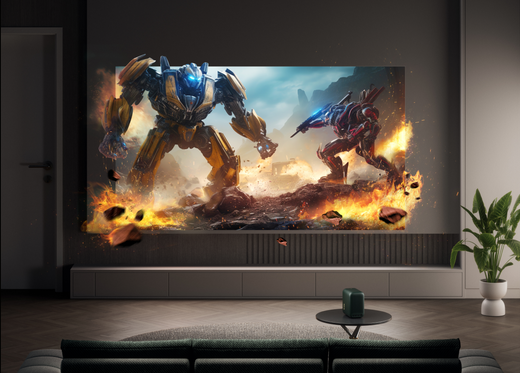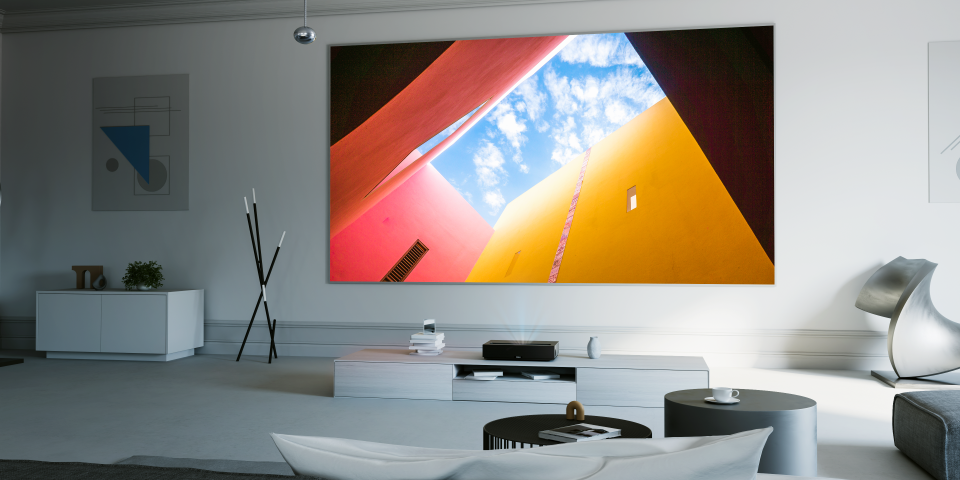LCD vs. DLP Projectors: Which One's Right for You?

From humble beginnings centered around playing with light and shadows, projection technology has evolved rapidly throughout the last few decades. In 2024, the projector market was valued at US$1.68 billion and is projected to reach US$ 2.23 billion by 2031. However, as the projector technology advances, consumers are left with so many options that they might feel overwhelmed. So, we’ve decided to make that decision simpler for you by introducing a comprehensive guide to the LCD projector, all its benefits, and how it holds up against the DLP projector. First, let’s get a better understanding of what an LCD projector is.
What Is an LCD Projector?
A Liquid Crystal Display projector – or LCD projector – uses liquid crystal panels that are red, green, and blue to modulate light and project an image onto a screen. LCD technology is quite common in many other devices such as smartphones, TVs, and monitors. One of the major draws to LCD projectors is the high-quality images produced. An LCD projector provides brighter images, vivid color, and sharper details – even in low light conditions. This is what makes LCD projectors versatile and popular for home entertainment setups, business meetings, and classrooms. Now, let’s take a further look at some of the advantages of using an LCD projector.
Benefits of an LCD Projector
LCD projectors have been around for years now and with each new generation, they’ve only improved and become more efficient. These are some of the main benefits of using an LCD projector today.
Sharper Images
Projecting clear images is a common concern with projector technologies, however, an LCD projector seamlessly takes care of that issue. With liquid crystal panels, an LCD projector can create much sharper images with a higher resolution – effortlessly producing smoother images and enhancing the perceived overall brightness. This makes it ideal for presentations and entertainment.
High Contrast Ratio
The contrast ratio can make or break your projector experience. This is why LCD projectors are known for having high contrast ratios that ensure precise color reproduction – with vibrant colors.
Wider Viewing Angle
Projectors are typically built to accommodate a specific room or environment, which is why a wide viewing angle is crucial to ensure maximum image reproduction. LCD projectors feature a wide viewing angle to ensure that the display can be enjoyed from various positions within the room. This is great for large social gatherings, seminars, or classrooms.
Affordability
Generally, an LCD projector will cost much less than other projector types and suit consumers with a tighter budget. They are also much more energy-efficient by consuming less power than other projectors – making them the more financially viable option.
Portability
Most LCD projectors come in compact designs, making them easier to carry and travel with. The Xming Episode One boasts its compact and petite structure by measuring just 6.9 x 4.8 x 5.6 inches and weighing only 1.2 lbs. The projector hardly makes a dent in your luggage and is built with travel, outdoor movie nights, and easy storage in mind.
Connectivity and Flexibility
LCD projectors also provide a spectrum of connectivity possibilities. These include HDMI, VGA, and USB options to ensure that different devices can be connected and enjoyed. The Formovie Page One projector is also the world’s first Google TV LCD projector with certified Netflix – expanding your variety and options for entertainment.
While LCD projectors are a common technology these days, they are not the only type of projectors available. DLP projectors have also been on the market for quite some time and are often compared to LCD projectors when added to your cart. To properly compare the two technologies, let’s look at how they compare across different fields.
LCD vs. DLP Projectors
Digital Light Processing (DLP) projectors make use of a digital micromirror device made up of thousands of tiny mirrors that reflect light to produce images. In a DLP projector, each of these mirrors corresponds to a single pixel in the projected image. Typically, DLP projectors produce crisp and clear visuals that might appeal to film enthusiasts for their cinematic reproduction. However, both DLP and LCD projectors have their strengths when it comes to visual clarity. Let’s look at how they compare generally across different factors.
|
LCD Projectors |
DLP Projectors |
|
|
Visuals |
Brighter images and better color saturation for easier viewing in diverse environments with varying light levels. |
Sharp images and elevated color accuracy for high-quality films. However, DLP projectors may also experience rainbow projections – random splashes of color across the image. |
|
Technology |
Liquid crystal panels that modulate light to produce an image with superior color saturation. |
Chip with thousands of tiny mirrors to produce sharp images and color accuracy. |
|
Energy Efficiency |
More energy efficient with bulbs that produce more light with lower wattage consumption. |
Consumes a relatively larger amount of energy compared to LCD projectors. |
|
Brightness |
Brighter images due to the direct light passage through the liquid crystal panels. |
High brightness but comparatively lower than LCDs due to potential light loss from the color wheel or mirrors. |
|
Color Accuracy |
Vibrant and true-to-life color reproduction. |
A wider color gamut which might also lead to the "rainbow effect" issue. |
|
Resolution |
Typically offers a lower resolution, however, Formovie LCD projectors boast native 1080P full HD resolutions. |
Offer 4K resolutions for cinema-grade clarity. |
|
Maintenance |
May need more maintenance due to regular dust filter changes. However, the Xming Episode One is a fully enclosed optical projector for minimized light leakage and dust interference. |
Easier to maintain due to the sealed-chip design that does not require filters. |
|
Versatility |
LCD projectors are much more versatile and can be used in various rooms of different sizes with different light levels. They’re often most compatible with large spaces such as home entertainment setups, classrooms, and boardrooms. |
DLP projectors are ideal for home theater systems in mostly dim areas. |
|
Price |
LCD projectors are more affordable and will typically last longer with the right care. |
These are more expensive upfront. |
Choosing the Best LCD Projector for Your Needs
While both LCD and DLP projectors have their set merits and drawbacks, LCD projectors from Formovie offer a level of sophistication, convenience, and visuals that simply cannot be denied. Invest in a better form of projector excellence with the Xming Episode One and Xming Page One from Formovie and take your projector clarity to a new level – whether you’re watching movies with your friends, presenting projects to your clients, or teaching a new generation of young minds. The Formovie LCD projector range has something for everyone. Contact us today for more information and join a world of superior projection clarity.

